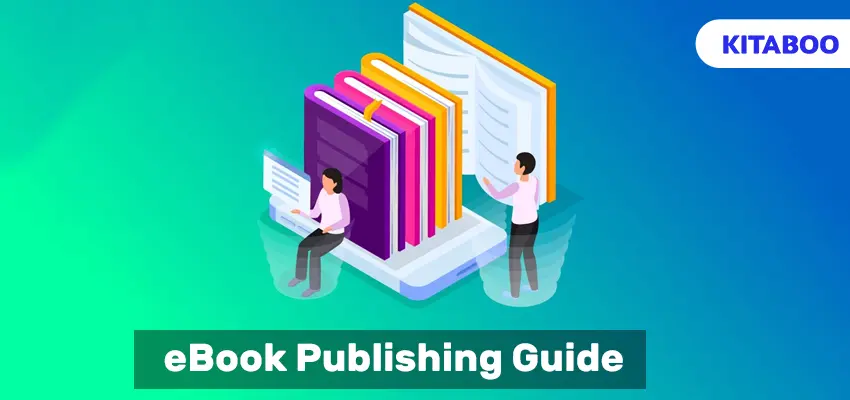
eBook Publishing Guide: Master The Process
Summarize this blog with your favorite AI:
eBooks are easy to acquire, read, resume, and carry everywhere – and this is just the tip of the iceberg that makes them a customer favorite. Publishing businesses find eBook publishing much more economical than traditionally printed books because of quicker processes and fewer expenses.
Additionally, eBooks are far more affordable for the masses as well, making them the preferred reading method for most audiences. However, businesses can only realize the advantages of eBook publishing when the entire process is done right and streamlined.
Through this guide, explore how eBook publishing is future-friendly and how your business can perfect the process to remain ready for all the opportunities that come your way.
Table of Contents
I. eBook Publishing: Is It Beneficial?
eBook Publishing: Is It Beneficial?
The short answer is – yes, eBook publishing has several qualities that enable businesses to remain resilient towards dynamic market demands.
There are certain advantages that make eBook publishing the smart way to walk into the future of publishing:
1. Reduced Publishing Costs
Digital publishing does not require any paper which is a significant saving on expenses in itself. Publishing businesses can save on not just the cost of paper but also save paper wastage that the process of proofreading and editing generates.
2. Wider Outreach
3. Less Environmental Impact
Your eBook publishing business would leave a far lesser environmental impact than print-publishing houses. This not only applies to the elimination of paper from the publications, but also awareness of paper use within the offices as well.
8-Step Guide to Mastering eBook Publishing
To ensure that your eBook publishing processes remain streamlined and well-orchestrated, follow the simple steps discussed below:
1. Do Market Research
The first step is to conduct a thorough market research that highlights the following points:
- The right target audience for each genre of the book your business publishes.
- The optimum number of pages for every genre of the book.
- The features and personalization that the target audience prefers their eBook readers to have.
Any insight that enables your business to provide the eBook and product that has a demand in the market can give you a competitive advantage.
2. Create the Content
In the second stage, set about creating the content. Leverage modern techniques like using interactive modules, introducing gamified sections, providing text-to-speech or screen readers, enabling audiobook capabilities, etc.
Leverage the market insight you gathered in the first step to create content along the same lines. Not only does this ensure that the book contains subjects your audience wants to read, but it also improves user engagement on your channels.
3. Validate the Content
Validation of content is the most important part of the eBook publishing process. If the eBook contains citations, references, facts, interviews, quotations, or any other data points that aren’t written by your writers, it is important to vet them.
Gather all the necessary permissions and rights to share the borrowed or second-hand data so that the readers may know your business verifies all information before presenting it. It helps to create an authoritative position in the market.
4. Edit the eBook and Create Marketing Copy
In the next step, your editors, proofreaders, and typesetters need to collaborate and thoroughly examine the content in the eBook for quality, readability, and correctness.
Additionally, you should now create the blurbs, descriptions, metadata, and other required marketing materials that would help you promote the eBook on various online channels and platforms.
Here, you can leverage the insight you gathered in the first step to write compelling marketing copies that appeal directly to the target audience.
5. Select the Right eBook Publishing Platform
The most crucial step of eBook publishing is selecting the right platform. An ideal eBook platform should help you consolidate all your publishing operations onto one interface, right from the creation of content to distributing the eBook.
Some of the key features of a good eBook publishing platform are:
- Analytics to show how eBooks and platforms are performing, whether readers are engaged, and more.
- Tools to consolidate content creation, editing, marketing, distribution, copyrights, and licensing.
- Sharing tools.
Guide:
Know How to Create an Interactive eBook
6. Optimize for SEO
In the next stage, the eBook content and all the marketing copies created need to be optimized for SEO.
Since this is an eBook, the primary method that the target audience will use to find it is a web search. Consider hiring SEO professionals to ensure that all your marketing material hits the mark.
It will also help your social media strategy and attract more leads.
7. Set Prices
Setting the right price can help an eBook sell quickly. The market research you performed initially will highlight the average price for which eBooks in each genre are retailing.
Make sure that your sales experts put the right price on the eBooks that justify the processes that went behind creating them.
8. Promote, Distribute, and Sell
In the final stage, you need to apply your marketing and sales strategies that promote your eBooks and get them selling through a variety of channels.
If you have an eBook reader platform like KITABOO, you need to apply your distribution strategies to make that content available to members.
KITABOO: Your Digital Publishing Partner
When it comes to eBook publishing success, the only aspect that truly makes a difference to the whole process is the platform you select. Highly capable and robust digital publishing platforms like KITABOO make it possible for the publishing business to elevate its workflows exponentially.
KITABOO provides device-agnostic content creation and publishing capabilities that are essential for large-scale publishing operations. Additionally, its easy integration into other enterprise systems makes it readily utilizable.
The platform also brings together all your publishing operations onto a single dashboard, enabling better control and visibility.
To explore more interesting features on KITABOO, contact us today!
Discover how a mobile-first training platform can help your organization.
KITABOO is a cloud-based platform to create, deliver & track mobile-first interactive training content.



